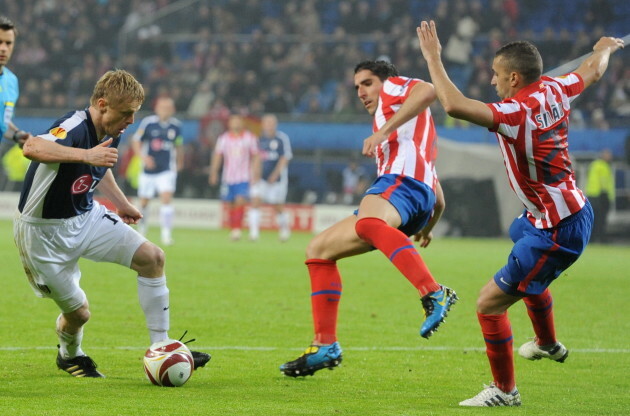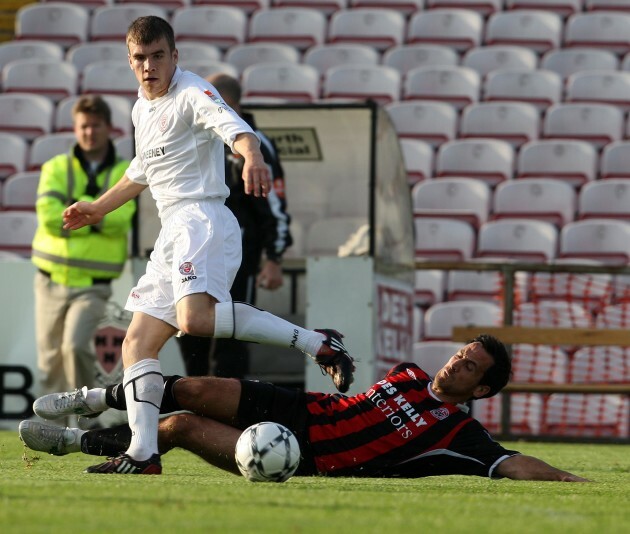THEY CLOSED THE medal factory in 2013. A production line that had been in operation for half-a-century came to a halt.
You’d have thought the FAI’s former chief executive – come executive vice-president – might have come up with a cunning plan to deal with the issue.
If you want to know what a big part of John Delaney’s legacy is to Irish football then here we go. There hasn’t been an Irish regular in the Manchester United first-team since John O’Shea; at Anfield since Robbie Keane; at Spurs since Robbie Keane; at Chelsea since Damien Duff; at Arsenal since Eddie McGoldrick; at Manchester City since Stephen Ireland.
Players from this country used to win things. From John Giles’ appearance in the 1967 Fairs Cup final through to Jim Beglin, Ronnie Whelan and Mark Lawrenson featuring in Liverpool’s 1-0 defeat to Juventus at Heysel, there was an Irish presence in 19 separate European finals. There hasn’t been one since Duff and Fulham lost the 2010 Europa League final.
We could go on. In the ‘80s, 22 Irish players pocketed medals from English football’s three major competitions, and that’s before we mention Liam Brady’s back-to-back title wins with Juventus or the double-winning Celtic trio (Bonner, McCarthy and Morris) who helped Ireland defeat England in Stuttgart.
The reason we’re going into a stat overload here is to point out that there was once a tradition in this country, at least one Irishman appearing on a League Cup winning squad every year from (Liverpool) 1981 through to (Aston Villa) 1996.
More impressive than that was the presence of at least one Republic of Ireland player in 31 of the 36 title winning squads from Liverpool’s triumph in 1975/6 up until Manchester United’s penultimate Premier League win in 2011.
The FA Cup was another goldmine, 11 different Irishmen winning the trophy between 1979 and 1989. But James McCarthy was the last to join this exclusive club in 2013, Keith Fahey and Steve Carr the last Irish players to win the League Cup in 2011, the same year O’Shea and Darron Gibson won the Premier League. Since then? Nothing. All those memories of Lawrenson, Whelan, Robinson, Beglin, Walsh, Hughton, Galvin and Sheedy appearing in European finals in 1984 and 1985 have faded.
You can point to football’s new landscape but only if you are searching for an excuse as well as a fact. Since 2010, when an Irishman last appeared in a European final, 48 different countries, including players from those renowned powerhouses of the world game, Gabon, Costa Rica, Georgia and Mali, have been represented in either the Champions League or Europa League finals.
You can point to the unique difficulties Irish football faces; the competition with GAA, the shadow of the Premier League. And then you see the rise of Irish rugby across the last 20 years.
Again you can find an excuse if you look hard enough for one, pointing to the fact that rugby, globally, is a smaller sport. Even so, the comparison is valid. The IRFU also had a sizeable contribution to make to the Aviva Stadium’s rebuild. Yet they managed it while also funding four professional teams, over 120 players, and the contracts of some of the world’s finest coaches.
Now look across Europe, to Croatia – a country with a slightly smaller population than Ireland, albeit a longer, richer tradition in the game arguabl. Eight of their players have made at least one appearance in a Champions League or Europa League final in the last decade, all bar one (the Swiss-born Ivan Rakitic) debuting in the Croatian national league before their 18th birthday.
Subsequently they were offloaded, Dinamo Zagreb selling Luka Modric for €16.5m, Mateo Kovacic for €11m, Simi Vrsaljko for €4.6m while Hajduk Split pocketed €7m for Nikola Kalinic. Think back to some of the better players who have come out of the League of Ireland – Kevin Doyle, Wes Hoolahan, Shane Long and Seamus Coleman. Between them, the four were snapped up for a combined total of about £350,000.
Other models can be looked at. The Portuguese are regarded as Europe’s star pupils in terms of player development, their 20 regional centres filled with coaches who require a university degree in physical education before they are allowed through the door. Now look at the impact Portuguese managers have made across the world, three different men winning South American, African and Chinese championships in the last 12 months, another four taking teams to the knockout stages of this year’s Europa League. Next think of Fernando Santos helping Portugal win Euro 2016 or even this chap called Jose Mourinho. By the way there is no manager from the Republic of Ireland working in Europe’s top five leagues right now.
Across Europe, different plans suit different cultures. A quartet of European countries, Russia and Ukraine initially, Belarus and Georgia more recently, have built residential coaching centres to house their country’s elite kids. Critics say their youth policy, a little like the Croat system, is unnecessarily ruthless, that too many players are discarded once their progress stalls.
A more favourable system to look at, coaching nerds tell us, is the Norwegian and Finnish one – countries who have spent heavily on youth development in the last seven years, with the Finnish investment repaid with qualification for Euro 2020, their first time to reach the finals of a major tournament.
You wonder if that kind of model would work better than a system within which our former chief executive used the company credit card to fork out €400 at a Tommy Hilfiger store and €226 in Thomas Pink.
You look back and despair at the money the FAI spent on Delaney’s exorbitant salary and pay-off, but also the absurd amounts paid to assistant managers and coaches – Marco Tardelli, Roy Keane and Robbie Keane. And for what? The money (a combined total in excess of €5m since 2008) has fattened the bank accounts of rich men when cheaper deals could so easily have been struck.
You think of the failure to sell Vantage Club seats at the Aviva Stadium and note that this was 2008 to 2010 when the Keane/Duff/Dunne/Given generation were ageing. That was the sliding doors moment, a time when Irish football needed millions put into an exceptional player development plan while the priority instead was servicing a bank debt.
You think of the fact Delaney had 14 years in the job, enough time to put a world-class structure in place. Did he? Well, here is what Liam Brady, a genuine great, had to say.
The emergence of one really talented player over the course of a decade is just not acceptable, something Delaney should not just be worried about in terms of his legacy — but ashamed of,” wrote Brady in his Irish Examiner column. “For me, the talent tap stopped flowing in the Steve Staunton era and a decade has been lost ever since. It goes without saying Brian Kerr should be brought back.”
It’s hard to disagree.
Not only does Irish football need a plan but Kerr has to the one who writes it.



